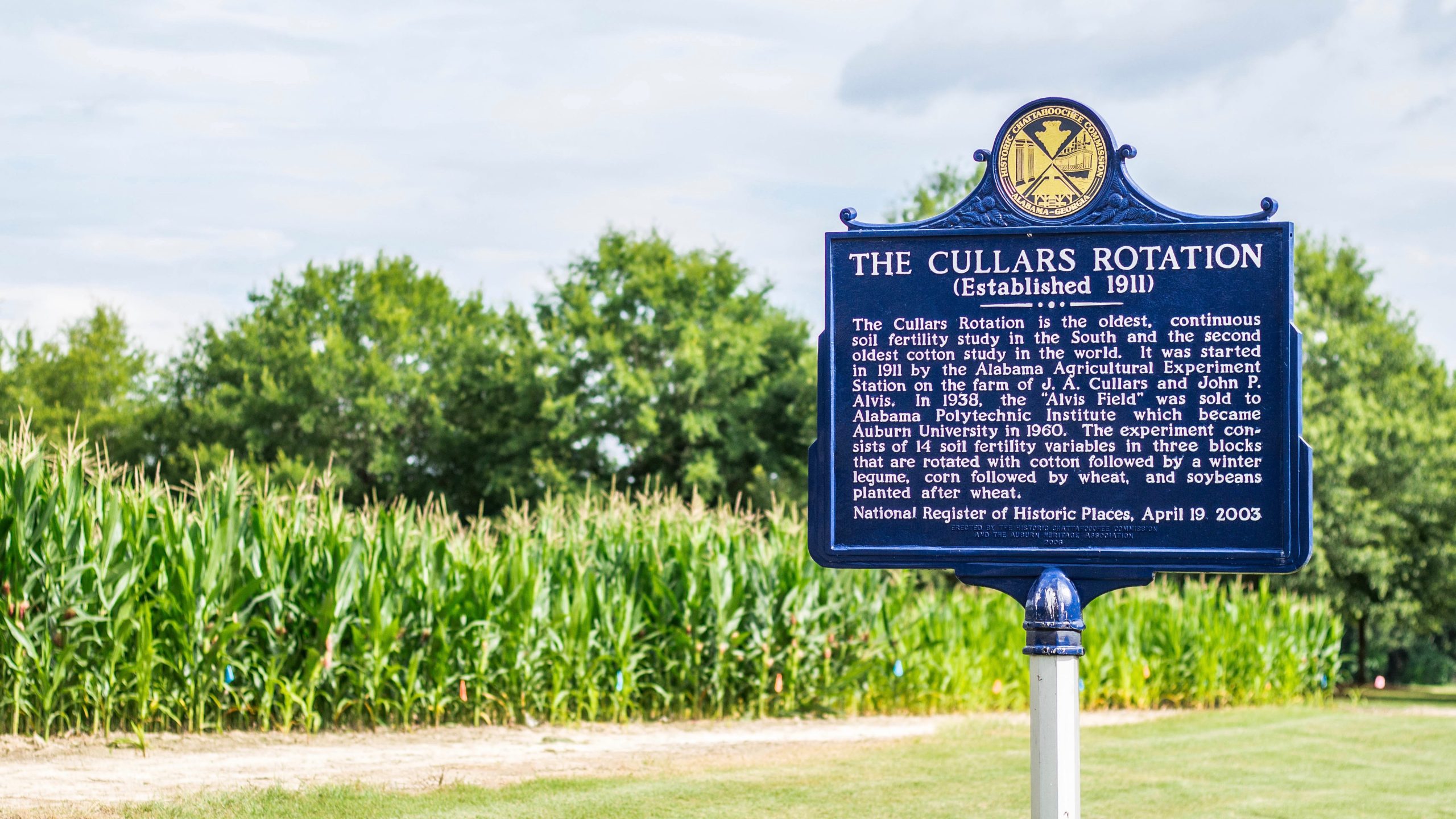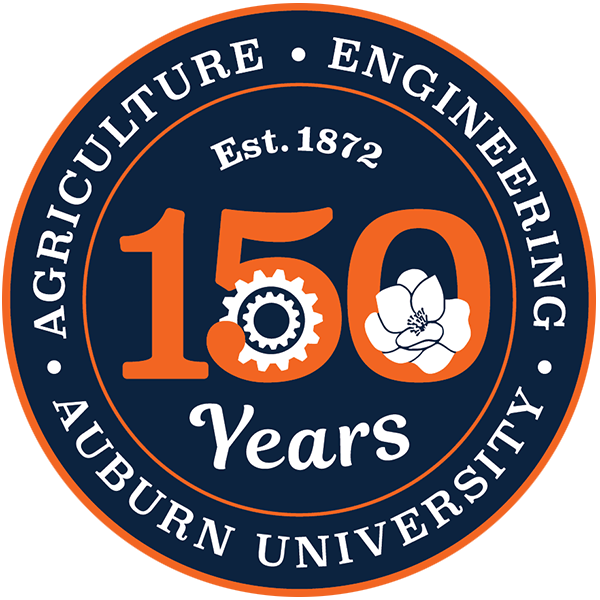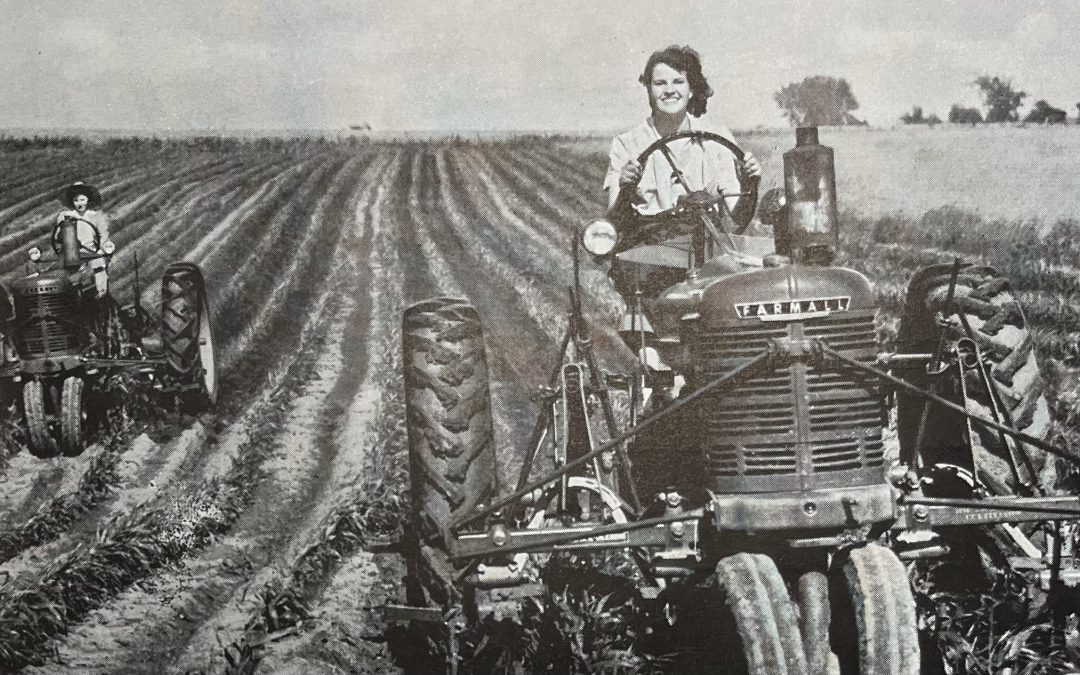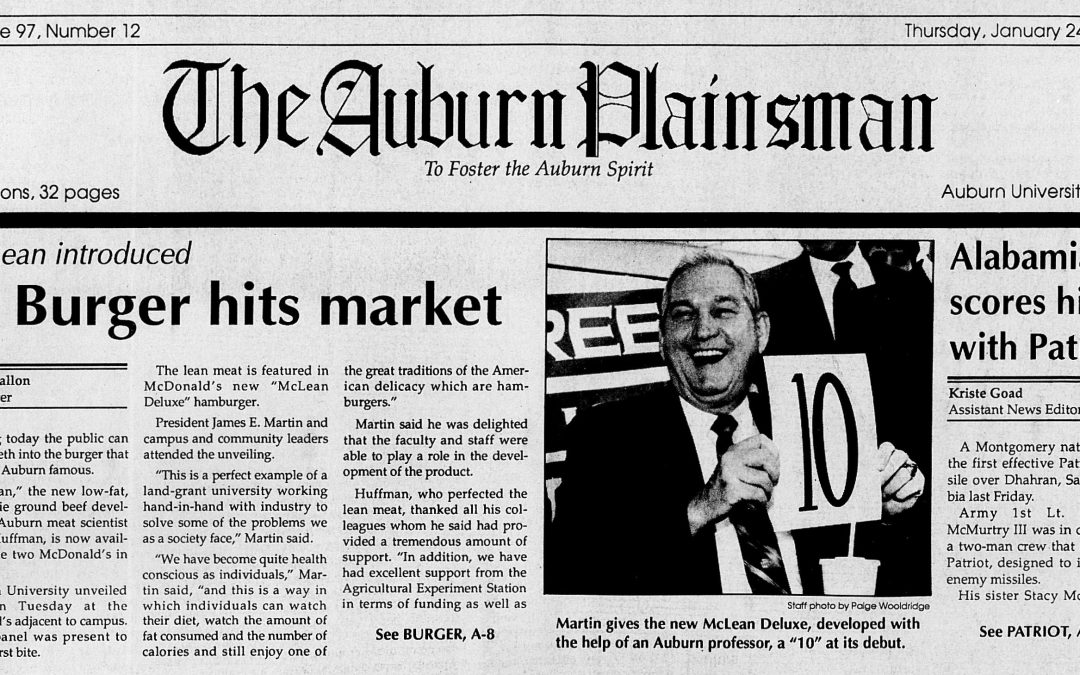Crop rotations tell rich history, point way for future of farming
THROUGHOUT THE 2022-2023 ACADEMIC YEAR, THE COLLEGE OF AGRICULTURE IS CELEBRATING ITS 150TH ANNIVERSARY WITH CONTENT SHARED FROM ITS SPECIAL COLLECTOR’S EDITION OF THE SEASON, PUBLISHING IN 2023.
It’s an anomaly on the Auburn University campus — a small plot of land that essentially looks as it always has for more than 100 years, even as a major research university has sprung up around it. In the shadow of an 88,000-seat football stadium and other multimillion-dollar structures sits the 1-acre Old Rotation.
And less than one mile away sits an equally unassuming 2-acre field, adjacent to — of all things — a world-class art museum: The Cullars Rotation.
Both stand as testaments to Auburn University and the College of Agriculture’s long-standing dedication to practical agricultural research. They are the epitome of living, breathing history, and they continue to point the way to the future for farmers in Alabama and throughout the world.
The Old Rotation had its beginning at the turn of the twentieth century, when Alabama boasted almost 8 million acres of cotton and corn, much of which was planted year after year on highly erodible land that was rapidly washing away.
In 1896, J.F. Duggar, agriculture professor at what was then the Agricultural and Mechanical College of Alabama, now Auburn University, began an experiment that aimed to demonstrate to farmers that sustainable cotton and corn production was possible if farmers would plant a winter cover crop and rotate their summer crops.
This project, now known as The Old Rotation, continues today. Since 1896, only minor modifications have been made in Duggar’s original demonstration, one of which came in 1997 when conservation tillage replaced conventional planting practices. The Old Rotation was placed on the National Register of Historical Places in 1988 and is the oldest continuous cotton study in the world.
The Cullars Rotation on the Alvis Field was named for J.A. Cullars, who owned and farmed the land with his brother-in-law, John Alvis, in the late 19th and early 20th centuries. In the 1880s, Professor George Atkinson, a biologist at the Agricultural and Mechanical College of Alabama, conducted cotton research on this site that led to the discovery that “cotton rust” was actually a potassium deficiency.
In 1911, this experiment was one of more than 200 established on farmers’ fields throughout Alabama to study crop response to added nutrients, especially potassium. This property was purchased by Alabama Polytechnic Institute in 1938. The Cullars Rotation experiment has been maintained and monitored since its beginning. Today, it provides us important information on the long-term effects of fertilization on sustainable crop production in sandy, Coastal Plain soils. In 2003, this site was placed on the National Register of Historical Places and is the oldest continuous soil fertility study in the South.
“Caretakers” continue mission of rotations
As with any fragile parchments of historical significance, the preservation of The Old Rotation and The Cullars Rotation has depended upon the reverence and dedication shown for them by their “caretakers.” The value in research seen by Duggar and Atkinson has been carried throughout the years by men and women who believed passionately that the past could instruct the future.
One of these caretakers is Charles Mitchell, Professor Emeritus in the College of Agriculture’s Department of Crops, Soil & Environmental Sciences.
Widely known both for his expertise in agronomy and encyclopedic knowledge of Alabama agriculture — especially agriculture as it relates to Auburn University — Mitchell began working with the crop rotations when he first joined Auburn’s faculty in 1984.
“If you ask me what my major accomplishments were during my 32 years on the faculty at Auburn, I would not hesitate to say it was getting these two experiments on the National Register of Historical Places and bringing international recognition of their contributions to agronomic science,” Mitchell said. “In these two experiments, a student, farmer or scientist is able to glean practical knowledge of what agronomy and soil science is all about.”
During his time working with the rotations, Mitchell witnessed more than a few major changes, including:
- In-row subsoiling to break up 100 years of soil compaction.
- Switching from conventional tillage to conservation tillage (strip tillage) in 1997.
- Switching from intensive, chemical-based pest control (mainly weeds and insects) to minimal dependency on chemicals (also in 1997) due to GMO crops and elimination of the cotton boll weevil.
- Irrigation in 2003.
“I cannot take credit for these changes,” Mitchell said. “Support from the USDA Soil Dynamics Lab enabled us to make these changes plus all the changes in agricultural systems leading up to them.
“The inclusion of the fields in the National Register of Historic Places brings national and international recognition to Auburn and to our predecessors at Auburn who saw the need to continue these experiments with little or no outside support.”
While determining the major contributions of these field to Alabama’s agricultural economy is more the job of administrators than agronomists, Mitchell says some benefits are obvious.
“The Old Rotation first demonstrated simple techniques to reduce or eliminate rampant soil erosion that robbed Alabamians of their livelihood in the 19th and early 20th centuries,” he said. “Most farmers, however, did not heed these results until the 21st Century.”
In 1896, Duggar said, “Alabama agriculture will come unto its own when her fields are green in winter.” He demonstrated this on The Old Rotation, but it took Alabama farmers another 100 years to make it happen, Mitchell said.
Winter cover crops alone can replace all of the nitrogen fertilizer needed for cotton in Alabama, he said. At current prices, that’s nearly $100 per acre.
“Many of the newer varieties of clover and vetch developed by the crops breeding program at Auburn over the years were in response to the needs of The Old Rotation,” Mitchell said. “Also, some of the first work under the umbrella of ‘soil quality/soil health’ came from these same plots.”
Innumerable graduate students and faculty in other disciplines, including nematology, plant pathology, entomology, botany and weed science have used these experiments for instructional purposes, he said.
Turning to The Cullars Rotation, it is believed that this site is where potash was first identified as an essential plant nutrient for cotton by George Atkinson in 1890, Mitchell said.
“In effect, this started the commercial fertilizer industry in the South because folks started importing kainite and later muriate of potash to fertilize their crops.
“Today, this is the only site in North America where one can see phosphate, potassium and sulfur deficiencies and low soil pH on five crops during a single year. That should be an invaluable resource on the campus of a land-grant university,” he said.
The Cullars Rotation was one of more than 100 experiments on farmers’ fields in 1911 that helped to develop fertilizer rates for farmers to use. Later, it contributed to soil test calibration and correlation when these technologies were introduced.
“This experiment allows us to study long-term nutrient movement and accumulation in our soils,” Mitchell said. “This cannot be done unless we have a long-term record of nutrient applications and removals. We’ve contributed soil from some of these plots that have been used in national exchange programs for quality control in soil testing labs throughout North America.”
It is vitally important to the future of agriculture research that long-term experiments like the ones at Auburn are preserved and continued, he said.
“One cannot study the long-term effects of agricultural practices, crop rotations, fertilization and soil changes unless there are sites with these records,” Mitchell said. “I have been amazed over the years when new theories or concepts of crop production pop up, and we can often find the answer in these historic, long-term plots.”
Mitchell said one example of this is the concept of Soil Quality/Soil Health. Now a national issue that started in the Midwest, the concept has been demonstrated on the Old Rotation since it began in 1896. Another example is from the 1980s, when the concept of “Low Input Agriculture” was developed.
“Look at The Cullars Rotation,” he said. “Low input equals low output. The ‘no additive’ plots yield almost nothing today.”
When Mitchell officially retired from Auburn University, Audrey Gamble, an assistant professor and extension specialist in the Department of Soil & Environmental Sciences, began overseeing The Cullars Rotation and The Old Rotation in 2017, working closely with Dennis Delaney, agronomist and professor emeritus.
“I definitely do feel a caretaker’s role for these fields,” Gamble said. “If anyone ever tried to take them away, I’d be the first one out there protesting. Over the years, a lot of people have overseen the plots and insured that they stayed in place.
“I’m excited to carry on that tradition. There are so many things that we still learn from these two rotations. They are extremely valuable to the history and tradition of Auburn University and the College of Agriculture, and we’ll do everything we can to continue this into the future.”
The challenge, Gamble said, is maintaining the integrity and overall design of the 100-year-plus experiments while making them relevant for farmers today.
“Every year we get variety trial data from both the official variety trials that take place on our regional research and experiment stations as well as from our on-farm variety trials, and we make decisions on the varieties we’ll plant based on what has performed well for certain areas,” Gamble said.
“We continue to update varieties and management based on what farmers are currently doing in Alabama. The crop rotations have remained consistent for more than a century now with slight alterations. For example, there have been years when wheat wasn’t as prevalent and oats and rye were planted.”
A fascinating aspect of the experiments is how they can be adapted to test new technology, Gamble said.
“As science advances, we come up with new research questions to ask, and there are numerous projects that currently are going on at both fields,” she said. “For example we’re looking at how soil microbial community structure has changed in these long-term rotations.
“It’s very important that we have long-term rotations to get good data on how the soil microbial community is changing. We’ve been able to use new technology and extract DNA from the soil to examine what is present in the soil and determine how long-term fertility and crop rotation affect those microbial communities. We also can look at how soil microorganisms are affected and how that affects crop production.”
Numerous faculty in different departments conduct projects in the rotations, Gamble said, in addition to people from outside Auburn University who come in and conduct experiments.
“One exciting project is that in 2019, the National Soil Health Institute sampled more than 100 long-term experiments throughout the United States, Canada and Mexico, and we were a part of that,” she said. “They measured a wide array of soil properties that went into a large meta-analysis to see how soil productivity is being affected in the long term.”
The historic rotations also are invaluable teaching tools, Gamble said.
“It’s so unique that we are able to take students who are learning about nutrient management out to The Cullars Rotation and show them a plot that has never received nitrogen,” she said. “We can show what fertility deficiencies look like in the field. In many courses, students would see only pictures. We can dig up soil and show differences in structure and organic content. We can show students and visiting farmers up close.”
The future of the experiments is not guaranteed, but Gamble is confident they’ll continue to point the way for farming in Alabama.
“We’ll have to continue to receive funding and find people to continue to maintain the rotations,” she said. “We can make them viable for years to come with the needed funding and good people to manage them. We can learn a lot from the short-term experiments we conduct on our research stations, but when it comes to building soil quality, much of the information comes from long-term plots.”






